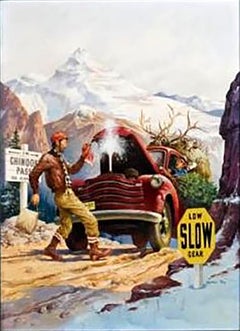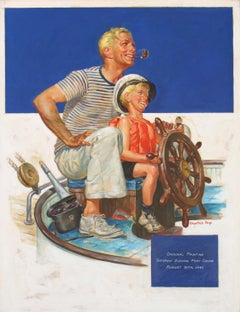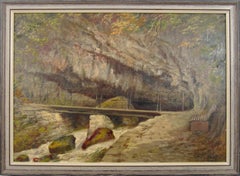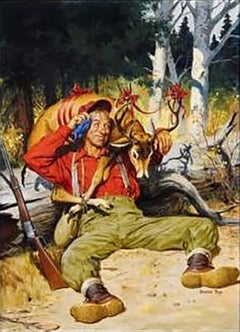Charles Dye Paintings
to
2
2
1
1
Overall Height
to
Overall Width
to
2
2
1
1
1
1
1
2
1
2
858
657
648
610
2
2
2
Artist: Charles Dye
Chinook Pass, Outdoor Life Magazine Cover
By Charles Dye
Located in Fort Washington, PA
Outdoor Life Magazine Cover, December 1955
Signed Lower Right
Category
20th Century Charles Dye Paintings
Materials
Board, Oil
Saturday Evening Post Cover, August 30, 1941
By Charles Dye
Located in Fort Washington, PA
Date: 1941
Medium: Oil on Board
Dimensions: 32.00" x 26.00"
Signature: Signed Lower Right
Cover of The Saturday Evening Post Magazine, ...
Category
1940s Charles Dye Paintings
Materials
Oil, Board
Related Items
Ralph R. Stubbs - Low tide at Sunset - English 19th Century Marine Oil Painting
By Ralph Reuben / Ruben Stubbs
Located in Meinisberg, CH
Ralph Reuben/Ruben Stubbs
(English, 1824-1879)
Low Tide at Sunset
• 19thC Oil on artist board (card) ca. 21 x 36.5 cm
• Signed bottom right and verso
Biografie:
Stubbs Ralph Reu...
Category
1860s Impressionist Charles Dye Paintings
Materials
Oil, Cardboard
Free Shipping
H 8.27 in W 14.38 in D 0.08 in
Rudolf Johann Weiss ( 1846 – 1933 ) Twannbach Cave Oil Painting Switzerland 1926
By Rudolf Johann Weiss
Located in Meinisberg, CH
Rudolf Johann Weiss
(Swiss, * 3.9.1846 Basel, † 17.4.1933 Biel)
Die Twannbachgrotte/Twannbachschlucht bei Twann, Biel, Schweiz
(= The Twannbach Cave/Twannbach Canyon by Douanne, Bie...
Category
1920s Post-Impressionist Charles Dye Paintings
Materials
Oil, Board
Free Shipping
H 10.83 in W 14.77 in D 1.19 in
Couple by Farmyard oil painting by Martha Cahoon
By Martha Cahoon
Located in Hudson, NY
Signed "Martha Cahoon" lower right.
Provenance: private collection, Palm Beach Florida
About this artist: Born of Swedish immigrant parents in 1905, in Rosindale, Massachusetts, Martha Farham Cahoon had a highly successful business partnership with her husband Ralph Cahoon...
Category
1960s Folk Art Charles Dye Paintings
Materials
Oil, Board
Army Poker
Located in Los Angeles, CA
This work is part of our exhibition - America Coast to Coast: Artists of the 1940s
Army Poker, c. 1943, probably tempera on board, signed upper right, 16 x 20 inches, inscribed verso a) “Army Poker / Mervin Honig / 421 W 42 St. N.Y.C.,” b) “Mervin Honig / US Army Air Force – Seymour Johnson Field – Goldsboro, NC / Circa 1943,” and c) “(This painting was done before men was (sic) shipped off to the Mariana Islands (Saipan) The Second World War.” Note: four pencil sketches for this work included
Mervin Honig was a New York-based painter and illustrator who is best known for his realistic depictions of everyday life and sports themes. Honig was raised in Brooklyn and recalled almost never being without a paintbox in hand from the time he started elementary school. Honig had a deep reverence for the Old Master painters, Vermeer and Bellini, as well as the Americans Winslow Homer and Thomas Eakins. He initially studied art from 1939 through 1941 with Francis Criss. At the outbreak of World War II, Honig worked as a mechanic for Republic Aviation, but in August 1942, he enlisted in the US Army Air Corps and was stationed at Seymour Johnson Field in Goldsboro, North Carolina. During the war, Honig began to exhibit nationally, including as part of the Portrait of America exhibitions which originated at the Metropolitan Museum of Art and traveled around the country, as well as at the Carnegie Institute in Pittsburgh. He painted Army Poker in 1943 while stationed at Johnson Field. In this work, Honig draws inspiration from Paul Cezanne's The Card Players (Metropolitan Museum of Art), with a similar placement of the four figures, but Cezanne's table is replaced with an Army cot, the pipe rack with a soldier's mess kit and the drapery in the right background with a heap of discarded uniforms. Unlike the vibrancy of Cezanne's composition, the limited palette of Honig's work suggests the drabness and monotony of stateside Army life.
After being discharged from military service, Honig furthered his studies with Amadee Ozenfant in 1946 and Hans Hoffman from 1947 through 1950. Additional exhibitions included the Whitney Museum of American Art, the Brooklyn Museum, the Los Angeles County Museum of Art, the National Academy of Design, the Wadsworth Atheneum, the Provincetown Art Association, and the National Academies Galleries of the Allied Artists Association. He was represented by the venerable Frank Rehn...
Category
1940s American Realist Charles Dye Paintings
Materials
Oil, Board, Tempera
Oil painting of Dutch town Deventer, The mint, J. A. van Schooten (1870-1933)
By Jan Antonius van Schooten
Located in DEVENTER, NL
J. A. van Schooten (1870-1933)
'The mint, Deventer'
Signed lower left J. v. Schooten
Maroufle (oil on canvas on board)
Dimensions without frame: 26 x 34 cm.
Dimensions with frame: 4...
Category
Early 20th Century Charles Dye Paintings
Materials
Board, Canvas, Oil
H 15.75 in W 18.51 in D 1.97 in
African House
Located in Metairie, LA
Clementine Hunter, African House
This is an excellent example of Hunter’s work, featuring the iconic African House. Three figures are present in the work, a boy, a girl, and an elde...
Category
1960s Folk Art Charles Dye Paintings
Materials
Pencil, Board, Oil, Canvas
Still life with peaches, oil painting by Pierre Coquet
Located in Montfort l’Amaury, FR
Pierre Coquet - Still life with peaches
Reference number F357
Framed with an ebony color wood floated frame.
41 x 58 cm frame included (21 x 38 cm withou...
Category
1980s French School Charles Dye Paintings
Materials
Oil, Board
Circle of Amico Aspertini, The meeting of Anna and Gioacchino
Located in Tricase, IT
Circle of Amico Aspertini
Oil on panel, 59x31 cm.
Provenance: Asta Pandolfini 8 marzo 2023 lot. 47.
He was born in Bologna to a family of painters (including Giovanni Antonio Asperti...
Category
16th Century Renaissance Charles Dye Paintings
Materials
Oil, Board
H 12.21 in W 23.23 in D 1.97 in
Daytime Watering Hole at Well in French Village 19th Century Oil Painting
Located in Stockholm, SE
This beautiful painting depicts a crowded scene of a watering hole at a well in the midst of a sunny, hot day, located on the street of a provincial village supposedly located somewh...
Category
Late 19th Century Realist Charles Dye Paintings
Materials
Oil, Cardboard
Untitled (Transcendental Composition)
By Charles Ragland Bunnell
Located in Los Angeles, CA
This work is part of our exhibition - America Coast to Coast: Artists of the 1940s
Untitled (Transcendental Composition), oil on board, 1947, oil on board, signed and dated lower r...
Category
1940s American Modern Charles Dye Paintings
Materials
Oil, Board
Man Reaching Down: Tondo
By Michael Leonard
Located in London, GB
Alkyd-oil on Masonite, signed and dated (middle left), 61cm (diam.), (83cm diam. framed). (This work was kept by the artist for his personal collection. It remained in his collection...
Category
1980s Post-War Charles Dye Paintings
Materials
Oil, Board
Family Portrait Mother with Children Playing Coins Framed Antique Oil Painting
Located in Stockholm, SE
Family genre scene late 19th early 20th century. The boy, tired of posing for a portrait painter, decided to play by spinning a coin on the table, this game greatly impressed his you...
Category
Early 20th Century Realist Charles Dye Paintings
Materials
Wood, Oil, Cardboard
Previously Available Items
Happy Hunter, Outdoor Life Magazine Cover
By Charles Dye
Located in Fort Washington, PA
Outdoor Life Magazine Cover, December 1951
Signed Lower Right
Category
1950s Charles Dye Paintings
Materials
Board, Oil
Big Catch, Outdoor Life Magazine Cover
By Charles Dye
Located in Fort Washington, PA
Big Catch, Outdoor Life Magazine Cover
Cover of Outdoor Life Magazine, August 1953
A dad and son fishing together.
Charles Dye was born October 30, 1906 in Canon City, which the artist referred to as a "Colorado cowtown" where he first rode for ranches as a boy. He worked as a cow hand until he was twenty-one, and travelled with herds to California and Oregon. "I cannot recall a time when I was not on horseback, or not portraying the ranching life in pen and pencil." In 1929 while recovering from an accident, Charlie saw a book about the western artists, Charlie Russell, which inspired him to become an artist. Apparently Charlie Dye had a difficult challenge in winning approval for his chosen profession from his father. According to the artist,"My old man could have forgiven me if I had decided to be a piano player in a whore house, but an artist rated one step below a pimp in his book!" In 1932 Dye moved to Chicago to work in the cattle yards, while he studied night classes at the Chicago Art Institute. In 1936 he moved to New York City and opened his own freelance art studio at 166 East 56th Street. In 1938 Dye studied with Harvey Dunn at the Grand Central School of Art. His first freelance assignments were interior story illustrations for the western pulp magazines published by Popular Publications. He later sold pulp covers to Popular's Adventure Magazine and Argosy. During WWII Charles Dye received assignments from slick magazines which were in need of professional freelance illustrators to replace the talent drain that was caused by the mobilization. Dye found work at The Saturday Evening Post. In the 1950s, Charles Dye received regular assignments to paint the covers and interior story illustrations for men's adventure magazines such as Saga, Outdoor Life, and Argosy. As changing tastes made it more difficult for clasic illustrators to find work, Charles Dye returned to his roots and painted Western art for the rest of his life. He moved to Sedona, Arizona in 1962, and helped to found the Cowboy Artists of America, along with Tom Lovell and Nick Eggenhofer...
Category
1950s Other Art Style Charles Dye Paintings
Materials
Oil, Board
Tax Forms Blues
By Charles Dye
Located in Fort Washington, PA
Charles Dye was born October 30, 1906 in Canon City, which the artist referred to as a "Colorado cowtown" where he first rode for ranches as a boy. He worked as a cow hand until he was twenty-one, and travelled with herds to California and Oregon. "I cannot recall a time when I was not on horseback, or not portraying the ranching life in pen and pencil." In 1929 while recovering from an accident, Charlie saw a book about the western artists, Charlie Russell, which inspired him to become an artist. Apparently Charlie Dye had a difficult challenge in winning approval for his chosen profession from his father. According to the artist,"My old man could have forgiven me if I had decided to be a piano player in a whore house, but an artist rated one step below a pimp in his book!" In 1932 Dye moved to Chicago to work in the cattle yards, while he studied night classes at the Chicago Art Institute. In 1936 he moved to New York City and opened his own freelance art studio at 166 East 56th Street. In 1938 Dye studied with Harvey Dunn at the Grand Central School of Art. His first freelance assignments were interior story illustrations for the western pulp magazines published by Popular Publications. He later sold pulp covers to Popular's Adventure Magazine and Argosy. During WWII Charles Dye received assignments from slick magazines which were in need of professional freelance illustrators to replace the talent drain that was caused by the mobilization. Dye found work at The Saturday Evening Post. In the 1950s, Charles Dye received regular assignments to paint the covers and interior story illustrations for men's adventure magazines such as Saga, Outdoor Life, and Argosy. As changing tastes made it more difficult for clasic illustrators to find work, Charles Dye returned to his roots and painted Western art for the rest of his life. He moved to Sedona, Arizona in 1962, and helped to found the Cowboy Artists of America, along with Tom Lovell and Nick Eggenhofer...
Category
Other Art Style Charles Dye Paintings
Materials
Board, Oil
Charles Dye paintings for sale on 1stDibs.
Find a wide variety of authentic Charles Dye paintings available for sale on 1stDibs. You can also browse by medium to find art by Charles Dye in board, oil paint, paint and more. Not every interior allows for large Charles Dye paintings, so small editions measuring 17 inches across are available. Customers who are interested in this artist might also find the work of Robert Riggs, Spencer Douglass Crockwell, and Alex Ross. Charles Dye paintings prices can differ depending upon medium, time period and other attributes. On 1stDibs, the price for these items starts at $5,900 and tops out at $129,000, while the average work can sell for $67,450.




